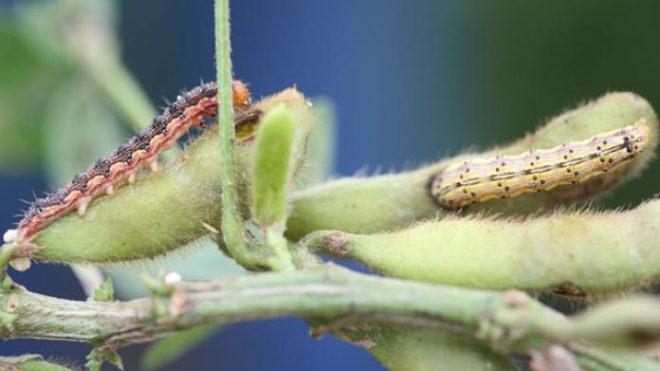The soybean Podworm (SPW) (Helicoverpa zea) feeds on many different grain and vegetable crops in much of the United States. SPW has many different names depending on which crop it is feeding on. These names include cotton bollworm, tomato fruitworm, sorghum headworm, and most commonly corn earworm. Often SPW is a soybean pest of the southern US; however, depending on several factors, this species can become a problem in soybean fields further north and east, making its presence felt in areas where it isn’t usually an economic pest.
SPW adults are moths that are very strong flyers. They are typically tan in color with a wingspan of around 1.5 in. A key identifier for the SPW moth is an easily visible black band on the front and rear wing tips. Adult female moths can lay more than 500 pearly white eggs. Each egg is laid singularly, which is different than many pest worm species. Many other species lay their eggs in groups or clumps on host plants.
In much of the Midwest, corn is the primary host of this pest. Some of the worms that infest our fields will have overwintered in our area. However, a significant number of moths migrate into the Midwest from the south, each boosting the population of SPW. We typically experience three generations of Helicoverpa zea in parts of the corn belt. The first generation will primarily reproduce on corn by feeding on ear tips in newly pollinated fields. Some of the second and third generations may then move out into soybean fields where they will lay their eggs which will result in pod-feeding damage.
SPW moths prefer open canopied soybean fields to lay their eggs. Therefore, late-planted and double-crop soybean fields are typically at higher risk for SPW infestation. Depending on the weather, eggs will hatch approximately one week after they are laid. Freshly hatched larvae are roughly 1/16 in. long. After growing through five or six larval stages over a few weeks’ time, a fully developed larva will be approximately 1.5 to 1.75 in. long before forming a pupa. The larvae of SPW will vary in color from light green to brown. They almost always have dark stripes down the length of their bodies and always have prominent, scattered spines.
Freshly hatched larvae will primarily feed on foliage, but they begin to feed on pods of soybean plants as they get larger. The larvae are aggressive feeders and quickly enter the pod to feed on the soybean resulting in direct yield loss. This is why SPW is such a significant pest when they infest soybean fields.
The easiest way to scout for SPW is to lay a white drop cloth between two soybean rows and shake the plants onto the cloth. Economic thresholds are met when one to two SPW are found per linear foot of row. Over the years, I have seen many fields that needed to be sprayed for this pest. In most cases, significant damage/ yield loss had already occurred. SPW typically cause damage to soybeans from the R1 through R5 growth stages. Once soybean plants reach R6, SPW feeding rapidly winds down. It is important to walk your fields frequently to scout for the many different pests that reduce our yields. SPW, in particular, is easy to miss. They are very hard to see, and most of the time, you won’t notice they are present until after they have already caused significant damage. Many insecticides are available to control this pest if treatment is required.
For more pest and agronomy articles like this: beckshybrids.com/Agronomy/Agronomy-Resources
~ Scott Dickey – MS, CCA – Field Agronomist

